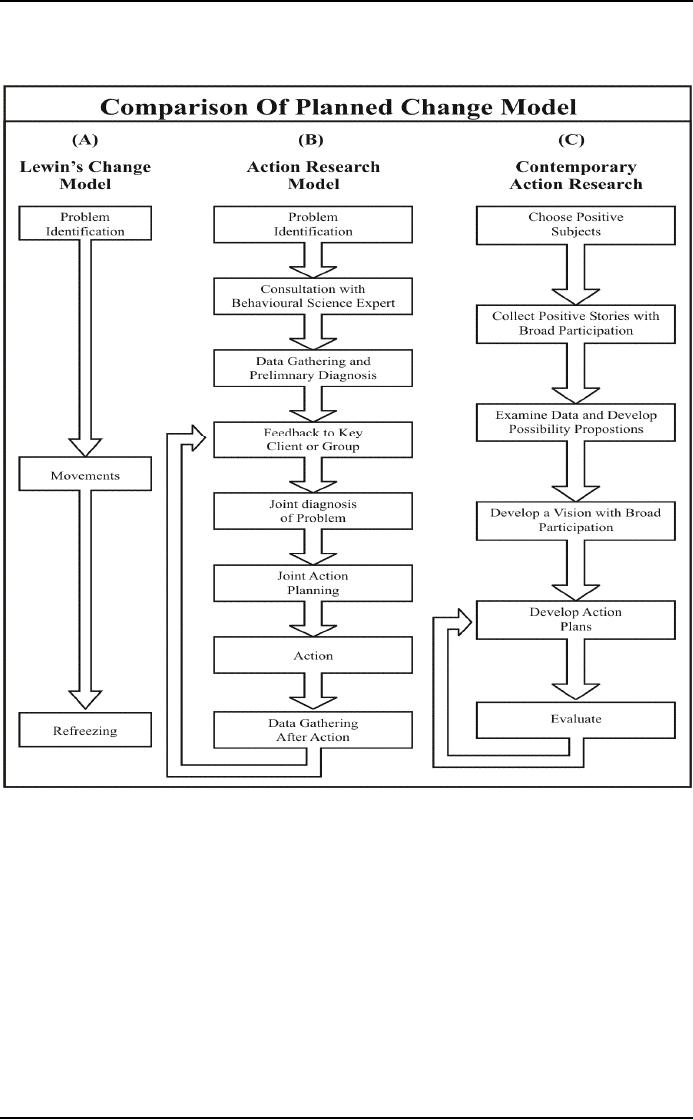 |

Organization
Development MGMT
628
VU
Lesson
07
The
Nature of Planned Change
The
pace of global, economic, and
technological development makes change an
inevitable feature of
organizational
life. However, change that
happens to an organization can be
distinguished from change
that
is
planned by its members. Here, the term
change will refer to planned change.
Organization development
is
directed at bringing about planned change
to increase an organization's
effectiveness. It is generally
initiated
and implemented by managers, often
with the help of an OD practitioner
either from inside or
outside
of the organization. Organizations can use planned
change to solve problems, to
learn from
experience,
to reframe shared perceptions, to
adapt to external environmental changes,
to improve per-
formance,
and to influence future
changes.
All
approaches to OD rely on some theory
about planned change. The
theories describe the
different
stages
through which planned change
may be effected in organizations
and explain the process of
applying
OD
methods to help organization members
manage change.
Theories
of Planned change:
The
three major theories of organization
change that have received
considerable attention in the field
are:
Lewin's
change model, the action research model,
and contemporary adaptations of action
research.
Lewin's
Change Model:
According
to the open-systems view, organizations--
like living creatures--tend to be
homeostatic, or
continuously
working to maintain a steady state. This
helps us understand why
organizations require
external
impetus to initiate change
and, indeed, why that
change will be resisted even
when it is necessary.
Organizational
change can occur at three
levels-- and, since the
patterns of resistance to change
are
different
for each, the patterns in
each level require different change
strategies and techniques.
These levels
involve:
1.
Changing
the individuals who work in the
organization--that is, their
skills, values, attitudes,
and
eventually
behavior--but making sure that
such individual--ehaviora4 change is
always regarded as
instrumental
to organizational change.
2.
Changing
various organizational structures and
systems--reward systems, reporting
elationships,
work
design, and so on.
3.
Directly
changing the organizational climate or interpersonal
style--how open people are
with
each
other, how conflict is
managed, how decisions are
made, and so on.
According
to Lewin, a pioneer in the field of
social psychology of organizations, the
first step of any
change
process it to unfreeze
the
present pattern of behavior as a way of
managing resistance to
change.
Depending
on the organizational level of change intended, such
unfreezing might involve, on the
individual
level,
selectively promoting or terminating
employees; on the structural level, developing
highly experiential
training
programs in such new organization
designs as matrix management;
or, on the climate level,
providing
data-based feedback on how
employees feel about certain management
practices. Whatever the
level
involved, each of these
interventions is intended to make organizational
members address that
level's
need
for change, heighten their
awareness of their own behavioral
patterns, and make them more
open to
the
change process.
The
second step, movement, involves making
the actual changes that will
move the organization to
another
level of response. On the individual level, we
would expect to see people behaving
differently,
perhaps
demonstrating new skills or new
supervisory practices. On the individual
level, we would expect to
see
changes in actual organizational
structures, reporting relationships,
and reward systems that
affect the
way
people do their work. Finally, on the
climate or interpersonal- style level, we
would expect to see
behavior
patterns that indicate greater
interpersonal trust and openness and
fewer dysfunctional
interactions.
The
final stage of the change
process, refreezing,
involves stabilizing or institutionalizing
these changes by
establishing
systems that make these
behavioral patterns "relatively secure
against change," as Lewin
put it.
The
refreezing stage may
involve, for example,
redesigning the organization's recruitment process
to
increase
the likelihood of hiring applicants
who share the organizations
new management style and
value
system.
During the refreezing stage, the
organization may also ensure
that the new behaviors have
become
the
operating norms at work, that the
reward system actually
reinforces those behaviors, or
that a new,
more
participative management style
predominates.
According
to Lewin, the first step to
achieving lasting organizational change
is to deal with resistance
to
change
by unblocking the present system. This
unblocking usually requires
some kind of confrontation
and
a
retraining process based on planned
behavioral changes in the desired
direction. Finally, deliberate
steps

Organization
Development MGMT
628
VU
need
to be taken to cement these
changes in place--this
"institutionalization of change" is
designed to
make
the changes semi-permanent until the
next cycle of change
occurs.
Figure:
07
Whatever
the level involved, each of the three
interventions is needed to make
organizational members
address
the level's need for change,
heighten their awareness of their
own behavioral patterns, and
make
them
more open to the change
process.
Stage
1: Unfreezing
Three
ways of unfreezing an organization
are:
i.
Disconfirmation
ii.
Induction
of guilt or anxiety
iii.
Creation
of psychological safety
i.
Disconfirmation or
lack of confirmation. Organizational
members are not likely to
embrace change
unless
they experience some need
for it. Embracing change
typically means that people
are dissatisfied with
the
way things are quality is
below standard, costs are
too high, morale is too
low, or direction is
unclear,
for
example.
Unfreezing
involves reducing those
forces maintaining the organization's
behavior at its present
level.
Unfreezing
is sometimes accomplished through a
process of "psychological disconfirmation."
By

Organization
Development MGMT
628
VU
introducing
information that shows
discrepancies between behaviors
desired by organization members
and
those
behaviors currently exhibited, members
can be motivated to engage in
change activities.
ii.
Induction of guilt or anxiety. This is a
matter of establishing a gap
between what is current but
not
working
well and some future
goal that would make things
work better. When people
recognize a gap
between
what is and what would be better and
more desirable, they will be
motivated via guilt or anxiety to
reduce
the gap. But disconfirmation
and induction are not enough
to accomplish the unfreezing stage.
One
more
process is necessary.
iii.
Creation of psychological safety. To
face disconfirmation, experience
guilt or anxiety, and be able
to
act
or move, people must believe
that moving will not
bring them humiliation or loss of
self-esteem. People
must
still feel worthy, psychologically
safe. The consultant must be
concerned with people not losing
face
and
must take care that
when people admit that something is
wrong they will not be
punished or
humiliated.
Stage
2: Moving (Changing)
The
second step, movement, involves making
the actual changes that will
move the organization to
another
level of response.
On
the individual level, we would expect to
see people behaving differently, perhaps demonstrating
new
skills
or new supervisory
practices.
On
the structural level, we would expect to see
changes in actual organizational
structures, reporting
relationships,
and reward systems that
affect the way people do their
work.
On
the climate or interpersonal level, we would
expect to see behavior
patterns that indicate
greater
interpersonal
trust and openness and fewer
dysfunctional interactions.
There
are two main processes
for accomplishing this
stage:
i.
Identification with a new
role model
ii.
Scanning the environment for
new information
i.
Identification with a new
role model, mentor, boss, or
consultant to
"begin to see things from
that
other
person's point of view. If we see another
point of view operating in a person to
whom we pay
attention
and respect, we can begin to
imagine that point of view
as something to consider for
ourselves".
ii.
Scanning the environment for
new, relevant information. In
working with the chairman of
a
company
and the president or CEO, the consultant
explored many reasons for
their conflict with
one
another.
To help with reducing some
of this conflict, the consultant worked on
clarifying roles and
responsibilities.
He quotes other chairman-president/CEO
models from other client
organizations, some
that
worked very well and some
that did not. This process
was an activity of bringing to the
two of them
new,
relevant information that might
help them move forward with the
changes needed in the
relationship.
Stage
3: Refreezing
This
final stage is one of
helping the client integrate the changes.
This stage involves stabilizing
or
institutionalizing
these changes by establishing
systems (such as norms,
policies, and structures)
that make
these
behavioral patterns "relatively secure
against change".
The
refreezing stage may
involve
�
Redesigning
the organization's recruitment process to increase the
likelihood of hiring
applicants
who
share the organization's new management
style and value
system.
�
During
the refreezing stage, the organization
may also ensure that the
new behaviors have
become
the
operating norms at work, that the
reward system actually
reinforces those behaviors, or
that a
new,
more participative management
style predominates.
This
stage can be seen in two
parts self and relations
with others:
i.
Personal
refreezing
ii.
Relational
refreezing
i.
Personal refreezing is the
process of taking the new, changed
way of doing things and making it
fit
comfortably
into one's total
self-concept. This process involves a lot
of practice trying out
new roles and
behaviors,
getting feedback, and making adjustments
until the new way of doing
things feels reasonably
comfortable.
ii.
Relational refreezing is the
process of assuring that the
client's new behavior will
fit with significant
others.
In a system, when one begins
to do things differently, will this difference
quickly affect others
with

Organization
Development MGMT
628
VU
whom
the person interacts? If you
and I interact frequently and I
change to maintain the relationship
you
will
have to change as well, at least to
some extent to maintain the relationship. This
process involves
openly
engaging with others about the
new way of doing things, to
help them see why the change is
better
than
the old way.
Case
Example: British Airways
In
1982 Margaret Thatcher's government in
Great Britain decided to
convert British Airways (BA)
from
government
ownership to private ownership. BA had regularly
required large subsidies from
the
government
(almost $900 million in
1982), subsidies that the government
felt it could not provide.
Even
more
important, the Conservative government
was ideologically opposed to the
government's ownership
of
businesses--a matter they regarded as the
appropriate province of private
enterprise.
The
growing deregulation of international air
traffic was another important
environmental change. Air
fares
were
no longer fixed, and the resulting price
wars placed BA at even
greater risk of financial losses.
In
order to be able to "privatize"--that
is, sell BA shares on the
London and New York
Stock
Exchanges--it
was necessary to make BA
profitable. The pressures to
change thus exerted on BA by
the
external
environment were broad and
intense. And the internal organizational
changes, driven by
these
external
pressures, have been massive
and widespread. They have transformed the
BA culture from what
BA
managers described as "bureaucratic and
militaristic" to one that is
now described as "service-oriented
and
market- driven." The success of
these efforts over a five-
year period (1982--1987) is
clearly depicted
in
the data.
This
figure 8 reflects BA's new
mission in its new advertising
slogan--"The World's Favorite Airline."
Five
years
after the change effort began, BA
had successfully moved from government
ownership to private
ownership,
and both passenger and
cargo revenues had
dramatically increased, leading to a
substantial
increase
in share price over the
offering price, despite the
market crash of October
1987. Indeed, in late
1987
BA acquired British Caledonian Airways,
its chief domestic competitor.
The steps through which
this
transformation
was accomplished clearly fit
Lewin's model of the change
process.
Table:
01
The
British Airways Success Story:
Creating the "World's
Favorite Airline"
1982
1987
Ownership
Government
Private
Profit/loss
$900
million
$435
million
Culture
Bureaucratic
and
Service-oriented
and market-driven
militaristic
Passenger
load factor
Decreasing
Increasing-up
16% in Ist
quarter
1988
Cargo
load
Stable
Increasing-up
41% in Ist
quarter
1988
Share
price
N/A
Increased
67% (2/11/87-8/11/87)
Acquisitions
N/A
British
Caledonian
Unfreezing:
In
BA's change effort, the
first step in unfreezing involved a
massive reduction in the
worldwide
BA workforce (from 59,000 to
37,000). It is interesting to note that,
within a year after this staff
reduction,
virtually all BA performance
indices had improved--more
on-time departures and
arrivals, fewer
out-of-service
aircraft, less time "on hold"
for telephone reservations, fewer lost
bags, and so on.
The
consensus
view at all levels within BA
was that the downsizing had
reduced hierarchical levels,
thus giving
more
autonomy to operating people and allowing
work to get done more
easily.
The
downsizing was accomplished with
compassion; no one was
actually laid off. Early
retirement, with
substantial
financial settlements, was the preferred
solution throughout the system.
Although there is no
question
that the process was
painful, considerable attention
was paid to minimizing the pain in
every
possible
way.
A
second major change occurred in
BA's top management. In
1981, Lord John King of Wartinbee, a
senior
British
industrialist, was appointed chairman of
the board, and Cohn Marshall, now
Sir Colin, was
appointed
CEO. The appointment of Marshall
represented a significant departure from
BA culture. An
outsider
to BA, Marshall had a marketing background
that was quite different
from that of his
predecessors,
many of whom were retired
senior Royal Air Force
officers. It was Marshall who
decided,
shortly
after his arrival, that BA's
strategy should be to become "the World's
Favorite Airline."
Without
question,
critical ingredients in the success of the overall
change effort were Marshall's
vision, the clarity of
his
understanding that BA's culture needed to
be changed in order to carry
out the vision, and his
strong
leadership
of that change
effort.

Organization
Development MGMT
628
VU
To
support the unfreezing process, the first
of many training programs
was introduced. "Putting
People
First"--the
program in which all BA personnel
with direct customer contact participated
- was another
important
part of the unfreezing process. Aimed at
helping line workers and
managers understand the
service
nature of the airline industry, it
was intended to challenge the
prevailing wisdom about how
things
were
to be done at BA.
Movement:
Early
on, Marshall hired Nicholas Georgiades, a
psychologist and former
professor and
consultant,
as director (vice president) of
human resources. It was
Georgiades who developed the
specific
tactics
and programs required to bring Marshall's
vision into reality. Thus
Georgiades, along with Marshall,
must
be regarded as a leader of BAS successful
change effort. One of the interventions
that Georgiades
initiated--a
significant activity during the movement
phase--was to establish training
programs for senior
and
middle managers. Among these
were "Managing People First"
and "Leading the Service
Business"--
experiential
programs that involved heavy
doses of individual feedback to
each participant about his
or her
behavior
regarding management practices on the
job.
These
training programs all had
more or less the same
general purpose: to identify the
organization's
dysfunctional
management style and begin the
process of developing a new management
style that would
fit
BA's new, competitive environment. If the organization
was to be market- driven, service-based,
and
profit-making,
it would require an open, participative
management style-- one that
would produce
employee
commitment.
On
the structures and systems level
during the unfreezing stage, extensive
made of diagonal task
forces
composed
of individuals from different
functions and at different
levels of responsibility to deal
with
various
aspects of the change process--the need
for MIS (management
information systems) support,
new
staffing
patterns, new uniforms, and
so on. A bottom-up, less
centralized budgeting process--one
sharply
different
from its predecessor--was
introduced.
Redefining
BA's business as service, rather
than as transportation, represented a
critical shift on the level of
climate/interpersonal
style. A service business
needs an open climate and
good interpersonal skills, coupled
with
outstanding teamwork. Off-site, team-building
meetings--the process chosen to
deal with these
issues
during
the movement stage--has now been
institutionalized.
None
of these changes would have
occurred without the commitment and
involvement of top
management.
Marshall himself played a central role in
both initiating and
supporting the change
process,
even
when problems arose. As one
index of this commitment, Marshall shared
information at question-
and-answer
sessions at most of the training
programs--both "to show the
flag" and to provide his
own
unique
perspective on what needed to be
done.
An
important element of the movement phase
was acceptance of the concept of
"emotional labor"
that
Georgiades
championed--that is, the high
energy levels required providing the
quality of service needed
in
a
somewhat uncertain environment, such as
the airline business. Recognition that
such service is
emotionally
draining and often can
lead to burnout and
permanent psychological damage is
critical to
developing
systems of emotional support for the
service workers
involved.
Another
important support mechanism
was the retraining of traditional
personnel staff to become
internal
change
agents charged with helping
and supporting line and
staff managers. So, too, was
the development
of
peer support groups for
managers completing the "Managing People
First" training
program?
To
support this movement, a number of
internal BA structures and
systems were changed. By
introducing
a
new bonus system, for
example, Georgiades demonstrated
management's commitment to sharing
the
financial
gains of BA's success. The
opening of Terminal 4 at Heathrow
Airport provided a
more
functional
work environment for staff.
The purchase of Chartridge House as a
permanent BA training
center
permitted an increase in and
integration of staff training, and the
new, "user-friendly" MIS
enabled
managers
to get the information they needed to do
their jobs in a timely
fashion.

Organization
Development MGMT
628
VU
Table:
02
Applying
Lewin's Model to the British
Airways (BA) Change
Effort
Levels
Unfreezing
Movement
Refreezing
Individual
Downsizing
of workforce Acceptance of
concept Continued
($9,000
to 37,000); middle of "emotional
labor".
commitment
of top
management
especially hard Personnel
staff
as
management.
hit.
internal
consultants.
Promotion
of staff
New
top management team.
"managing
people first" with new BA
values.
"putting
people first"
peer
support groups.
"Top
Flight
Academies".
"Open
Learning"
programs
Structures
and
Use of diagonal task forces to
Profit sharing (3weeks
New
performance
systems
plan
change.
pay
in 1987).
appraisal
system based
Reduction
in levels of Opening of
Terminal 4. on both behavior
and
hierarchy.
Purchase
of Chartridge performance.
Modification
of budgeting as training
center.
Performance-based
process
New,
"User-friendly" compensation
system.
MIS
Continued
use of task
forces
Climate/interpersonal
Redefinition of the business: Greater
emphasis on New
uniforms.
style
service,
not transportation.
open
communications. New coat of
arms.
Top-management
Data
feedback on Development and
use
and
work-unit climate.
of
cabin-crew teams.
commitment
Off-site,
team-building Continued use of
data-
involvement.
meeting.
based
feedback on
climate
and
management
practices.
Refreezing:
During
the refreezing phase, the continued
involvement and commitment of BA's
top
management
ensured that the changes
became "fixed" in the system.
People who clearly
exemplified the
new
BA values were much more
likely to be promoted, especially at
higher management levels.
Georgiades
introduced
additional pro-grams for
educating the workforce, especially
managers. "Open
Learning"
programs,
including orientation programs
for new staff, supervisory
training for new
supervisors, and so
on,
were augmented by "Top
Flight Academies" that included
training at the executive,
senior
management,
and management levels. One of the
academies now leads to an MBA
degree.
A
new performance appraisal
system, based on both
behavior and results, was
created to emphasize
customer
service and subordinate development. A
performance-based compensation system is
being
installed,
and task forces continue to
be used to solve emerging
problems, such as those resulting
from the
acquisition
of British Caledonian
Airlines.
Attention
was paid to BA's symbols as
well-- new, upscale uniforms; refurbished
aircraft; and a new
corporate
coat of arms with the motto
"We fly to serve." A unique development
has been the creation of
teams
for consistent cabin-crew staffing,
rather than the ad hoc process
typically used. Finally,
there is
continued
use of data feedback on
management practices throughout the
system.
Table of Contents:
- The Challenge for Organizations:The Growth and Relevance of OD
- OD: A Unique Change Strategy:OD consultants utilize a behavioral science base
- What an “ideal” effective, healthy organization would look like?:
- The Evolution of OD:Laboratory Training, Likert Scale, Scoring and analysis,
- The Evolution of OD:Participative Management, Quality of Work Life, Strategic Change
- The Organization Culture:Adjustment to Cultural Norms, Psychological Contracts
- The Nature of Planned Change:Lewin’s Change Model, Case Example: British Airways
- Action Research Model:Termination of the OD Effort, Phases not Steps
- General Model of Planned Change:Entering and Contracting, Magnitude of Change
- The Organization Development Practitioner:External and Internal Practitioners
- Creating a Climate for Change:The Stabilizer Style, The Analyzer Style
- OD Practitioner Skills and Activities:Consultant’s Abilities, Marginality
- Professional Values:Professional Ethics, Ethical Dilemmas, Technical Ineptness
- Entering and Contracting:Clarifying the Organizational Issue, Selecting an OD Practitioner
- Diagnosing Organizations:The Process, The Performance Gap, The Interview Data
- Organization as Open Systems:Equifinality, Diagnosing Organizational Systems
- Diagnosing Organizations:Outputs, Alignment, Analysis
- Diagnosing Groups and Jobs:Design Components, Outputs
- Diagnosing Groups and Jobs:Design Components, Fits
- Collecting and Analyzing Diagnostic information:Methods for Collecting Data, Observations
- Collecting and Analyzing Diagnostic information:Sampling, The Analysis of Data
- Designing Interventions:Readiness for Change, Techno-structural Interventions
- Leading and Managing Change:Motivating Change, The Life Cycle of Resistance to Change
- Leading and managing change:Describing the Core Ideology, Commitment Planning
- Evaluating and Institutionalizing Organization Development Interventions:Measurement
- Evaluating and Institutionalizing Organization Development Interventions:Research Design
- Evaluating and Institutionalizing Organization Development Interventions
- Interpersonal and Group Process Approaches:Group Process
- Interpersonal and Group Process Approaches:Leadership and Authority, Group Interventions
- Interpersonal and Group Process Approaches:Third-Party Interventions
- Interpersonal and Group Process Approaches:Team Building, Team Building Process
- Interpersonal and Group Process Approaches:Team Management Styles
- Organization Process Approaches:Application Stages, Microcosm Groups
- Restructuring Organizations:Structural Design, Process-Based Structures
- Restructuring Organizations:Downsizing, Application Stages, Reengineering
- Employee Involvement:Parallel Structures, Multiple-level committees
- Employee Involvement:Quality Circles, Total Quality Management
- Work Design:The Engineering Approach, Individual Differences, Vertical Loading
- Performance Management:Goal Setting, Management by Objectives, Criticism of MBO
- Developing and Assisting Members:Career Stages, Career Planning, Job Pathing
- Developing and Assisting Members:Culture and Values, Employee Assistance Programs
- Organization and Environment Relationships:Environmental Dimensions, Administrative Responses
- Organization Transformation:Sharing the Vision, Three kinds of Interventions
- The Behavioral Approach:The Deep Assumptions Approach
- Seven Practices of Successful Organizations:Training, Sharing Information